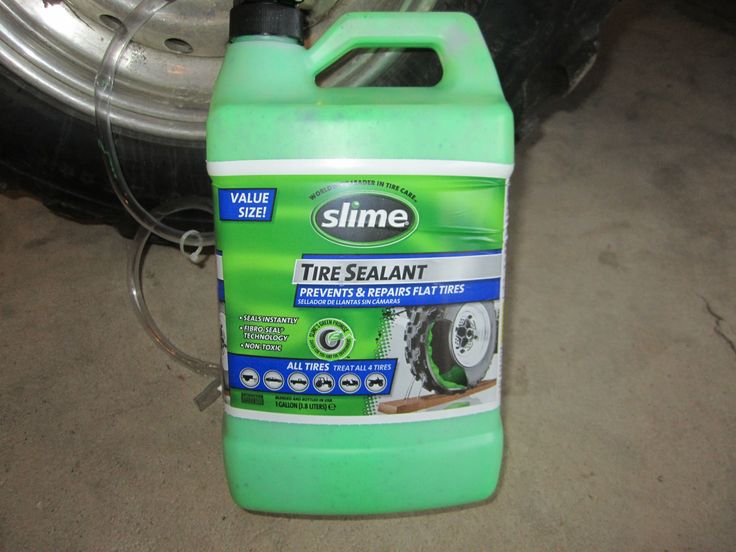Tire patches are a huge money maker for auto shops. They don’t require much labor, and the cost of a patch is really low compared to most other auto parts.
But what is a good price to pay to get a tire patched? Well, that depends. If you patch the tire yourself, expect to spend $6.00. If you take it to the shop, you’re looking at spending anywhere between $10-$40, depending on the situation.
Patching tires yourself is always everyone’s first instinct, since the cost is so low. But many people are deterred when they find out they can’t, due to any number of reasons. Deciding when to do it yourself, versus taking it to the shop is what we’ll explore in this article along with why tire patches can be so pricey. We’ll outline the different reasons you should, or shouldn’t do it yourself. We’ll also examine the different types of patches and the pros and cons of each.
I used to work at a shop on a main highway. Every day, during rush hour traffic, at least 3 customers came in requesting a tire patch. Over the years, I’ve learned the simplicity of the tire patch can be deceiving. Not all tires are created equal and the same goes for patches.
When a shop patches your tire, most of the cost stems from the mechanic’s time.The wholesale price of a tire patch is less than $2.00. The glob of bead sealer that’s used to seal the patch costs less than $0.10.
But it takes the average mechanic about 15 minutes to patch a tire. Most shops charge around $120 per mechanic hour, so you’re looking at $30-$40 for time and parts. If you want the tire re-balanced, as is recommended, tack on another $13.00.
While a tire patch is among the most simple jobs, it takes time away from mechanics who could be working on higher paying, more demanding jobs. Hence, the hourly rate being applied to the job.
Not all tires can be repaired. There are some tests that mechanics, or you yourself, can perform. Doing these tests will give you a good idea as to whether or not your tire can be repaired.
Doing these tests will give you a good idea as to whether or not your tire can be repaired.
When your tire becomes flat, the first thing to do is not drive on it. Driving on a flat tire, even for a short amount of time, can damage it beyond repair. When a tire is operated without air, the vehicle’s weight crushes the tire’s innards turning it to dust.
The next thing to do is see what caused the flat. Nails directly in the middle of the tread are a common occurrence. They can be easily spotted from a distance. If you can’t see it, running your hand around the tread will reveal the location of the nail.
Tire punctures that occur within 2 inches of the sidewall are considered non-repairable. This means neither you, nor the shop, can repair this.
It’s actually against the law for auto-shops to repair tires that have punctures close to the side wall. The issue is, tire patches placed close to the side-wall often result in tire blowouts, due to the shifting nature of a tire’s sidewall to tread relationship.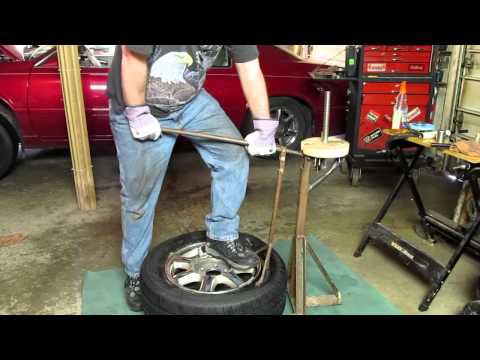
A good test to measure the distance between the puncture and the sidewall is to place your thumb in that space. If the puncture is a thumbs width (or more) away from the side wall, you’re in the clear.
If not, sadly, it’s time for a new tire.
The length of the puncture is the next thing to look at. Most nail punctures are just as wide as the nail itself. In this case, with the puncture being so small, it’s ok to plug the tire yourself. But if the length of the puncture is 2 ½ inches or more, you cannot patch it.
You cannot patch it, or a shop cannot either. Punctures this large are not repairable, because patches aren’t meant to hold in air over that big of an area.
The inner tire liner doesn’t become fully sealed, even with the largest patches available. If your puncture is more of a gash in the tread, it’s time for a new tire.
Fully patching a tire requires you to complete the following steps.

So as you can see, the full, official way to patch a tire is quite involved. This is why you can see prices up to $45.00 for a simple patch.
If the tire has to be rebalanced, that’s around $13.00 and if it needs new valve stems, or a TPMS sensor, this can also tack on extra costs.
This patch is so effective that it saves you from having to purchase a new tire. You can enjoy the full length of the tire as if no puncture ever happened. Patching a tire can be quite the life saver when you’re in a jam.
The obvious issue here is that tire machines aren’t commonplace in the average driver’s house. So doing it yourself this way isn’t really feasible, but the method we discuss next can be done almost anywhere.
Tire plugging is a simple fix applied to various types of tire punctures. The majority of tire punctures can be repaired by doing a plug yourself.
To plug a tire, just push the plugging strip with the T-Handle in as far as it will go. Then, with all your might, quickly pull the t-handle out. This will plug the tire, and all that’s left is for you to cut the excess plugging strip away.
Tire plugging is looked down by Tire Shops because they consider it not fully seal the surface. But I’ve plugged well over 500 tires, and have never had an issue. Most independent shops are fond of tire plugging as well, since it keeps prices down for them, and the customer.
Tire plugging can be done by yourself, in your driveway. If you don’t feel comfortable doing it, call up an independent shop and ask if they plug or patch tires. Most likely, they probably offer both, but they’ll charge half for a plug, compared to what they would for a full patch.
Most likely, they probably offer both, but they’ll charge half for a plug, compared to what they would for a full patch.
Plugging tires, while usually a simple task, can turn into a complex issue. For example, if you plug a tire, and you can still hear a slow hissing noise, it can be a pain to hunt down the source of the leak.
Or if you spray the whole tire down with soap in order to locate the leak, and can’t find it. You might start to question your sanity. Don’t! These issues can take up hours, even for master techs.
There’s actually a machine in some tire shops that puts the tire under water using a crane-like object from above. Even this machine still fails sometimes, and mechanics are left scratching their head. So if you start to encounter any issues of locating the leak, or plugging a leak, it’s time to take it to the shop.
If the tire is totally flat when you walk out to your car, you should be able to use your spare tire, and repair the issue at home with a plugging kit.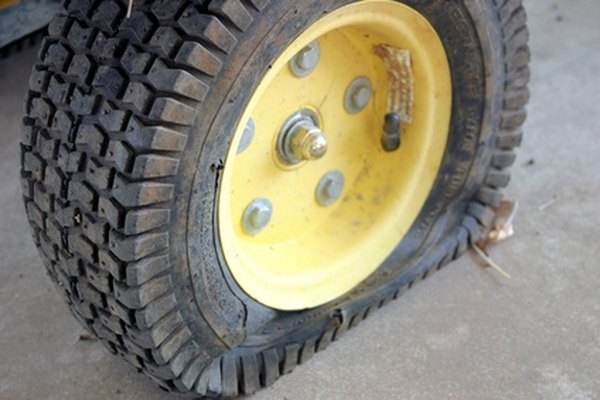 But if you plug the tire, and it’s still leaking, take it to the shop and let them repair it.
But if you plug the tire, and it’s still leaking, take it to the shop and let them repair it.
If you are questioning the length test or edge test results, it’s also recommended that you take it to the shop. Some mechanics will say, “use double the amount of plugs”, to fix large gashes. This is wrong. If one plug can’t fix it, take it to the shop and see what you can recoup.
But for the majority of situations, where a nail has punctured your tread somewhere in the middle of the tread face, it’s totally acceptable to purchase a plug kit, and do the repair yourself. It will save you a couple bucks, and you will have had the opportunity to go under your car to do a quick visual inspection. Or take off the tire and glance at the brake pads.
Tire patching is a method to restore the original appearance of the wheel part. People use the patch method because their car does not have too big a problem, and they just need to perform small tips to save the budget.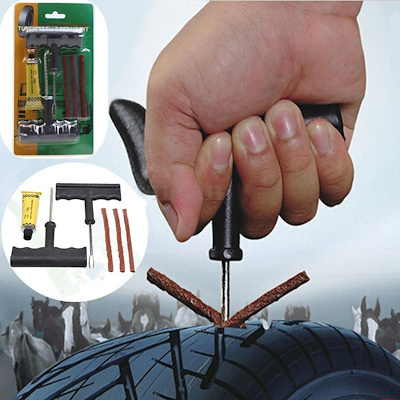
However, not everyone is good at this, and the best solution for them is to seek the help of repair shops. So, how much does it cost to get a tire patched?
This task will cost you between $5-$20, depending on the severity of the tear. Of course, some shops will give you free if you buy their replacement tires!
Why Do Tires Go Flat?The process of moving is subject to many external forces, causing the tires to deflate. The cause comes from many sides, but it is not a coincidence.
There are three ways to explain this phenomenon:
When it meets the right, less durable sides, it will puncture the tire, and the gas leak occurs the next day. However, the process will take a long time, depending on how severe the object has been.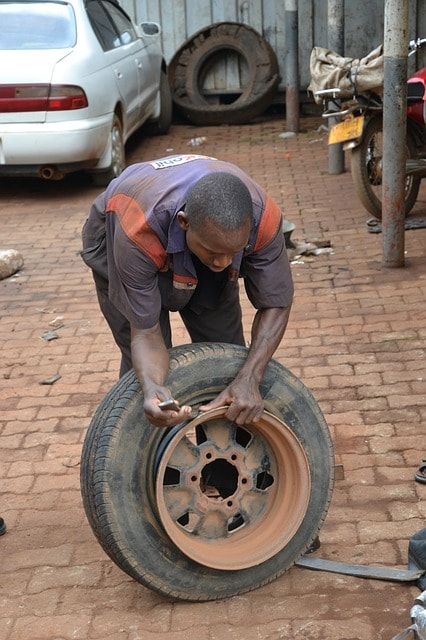
Can we take this as another way of stating protection? It’s not too difficult to do; even with just being meticulous, you have adequately protected your tires. Here are three measures to refer to:
Checking dailyRegularly taking your tires in for maintenance is the best way to protect your car. Here, the tires and the whole as a whole will be to detect potentially harmful problems and then provide solutions to protect and eliminate the risk. As for the tire, it will be to look for wounds, thereby limiting deflation.
As for the tire, it will be to look for wounds, thereby limiting deflation.
Although it is difficult to guarantee that it is 100% avoidable, try to keep the collision rate as low as possible.
When entering a road with signs under construction or places full of potholes, you should adjust your driving speed, carefully look at the road, and make sure the tires do not encounter dangerous objects.
Track tire recallsAlthough the manufacturing process of the auto industry is always rigorous, there are also shipments with incorrect specifications that cause dangers when used. You should follow the brand to know more about recalls, if any.
Is Tire Stickers Possible?It’s up to you whether you want to use a gluing service. Don’t confuse gluing with car patching. The meaning of the word “patch” is clearly as a measure to repair wounds and holes that make the car unable to operate. As for gluing tires, paste the letters on the wheel body to increase aesthetics.
It does not have any effect in protecting the wheel body. Although manufacturers do mention the longevity feature of long-lasting tires, it’s important to remember that there’s too much to decide whether the wheel or running tire itself will last a long time.
How Much Does It Cost To Get A Tire Patched?The cost depends on the selected maintenance center; the amount of this service is not uniform. But the number is not too expensive, ranging from $30-40$ for a patch.
A mechanic takes 15 minutes to remove the tire from the rim to find the leak and 20-30 minutes for the repair and finishing work.
Although the job is not too difficult, it requires a high level of skill, so for some shops, the price to fix the car can be higher than $5-10$. You can also buy the equipment and repair it yourself. But honestly, we don’t recommend this.
What If You Can’t Use The Tire Patch?In case you cannot repair the patch, then bring it to the center for support. There, they will have specialized tools and professional ways to ensure safety after patching. Mastering knowledge and experience is always good in all situations, primarily related to security.
There, they will have specialized tools and professional ways to ensure safety after patching. Mastering knowledge and experience is always good in all situations, primarily related to security.
Wheels always need to be in a stable gas state, and it helps maintain the movement and increase the ability to support the force. The gas pressure should not be too high or vice versa.
When the air in the wheel is too low, the speed of travel slows down, and the tires cannot overcome obstacles, especially rough roads.
But if it’s too tight, it will explode because it can’t handle operation pressures well. The primary advice is to use a dedicated gas pressure gauge to catch and control the gas in the wheel well.
Tire rotationPeriodically try to rotate the tire to prolong its life and evenly distribute the wear on all four wheels. Regardless of whether you do it yourself or with professional help, this is an excellent opportunity to grasp the damage situation that the vehicle is facing.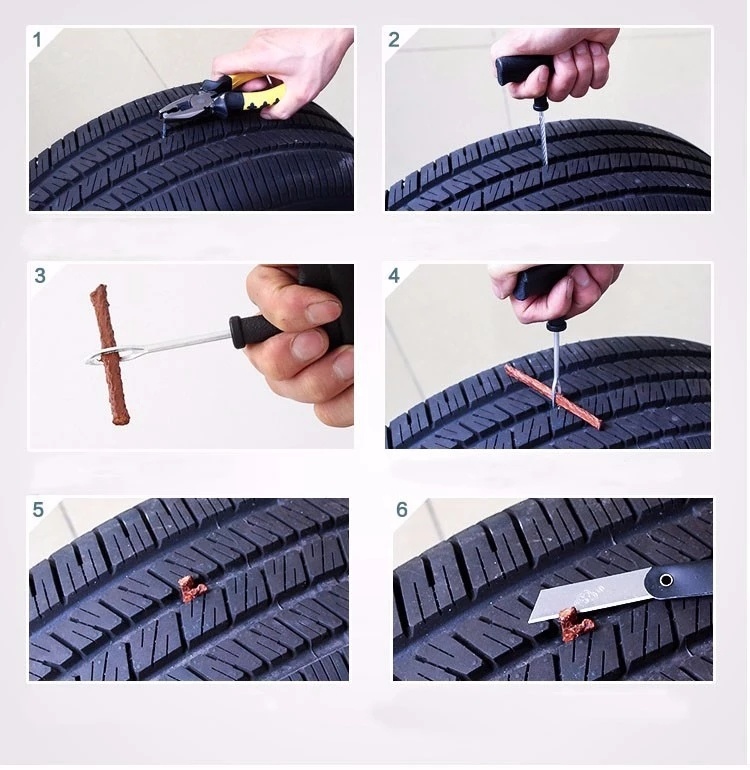
There are indicators recommended to users in each one, including the load that the tire can withstand and the notes not to do.
To ensure safety, you should carefully read the notes and avoid carrying too many unnecessary items to put pressure on the body and the wheels.
Tire balanceExperts recommend that users balance the tires after traveling 12,000 miles or when the car has problems with the steering wheel.
The balance helps evenly distribute the force on all four tires, limiting rapid wear. It also eliminates vibration, creating a comfortable feeling for the user.
For more tips, watch this video:
ConclusionAbove is the knowledge related to the tire patching process or wheel maintenance.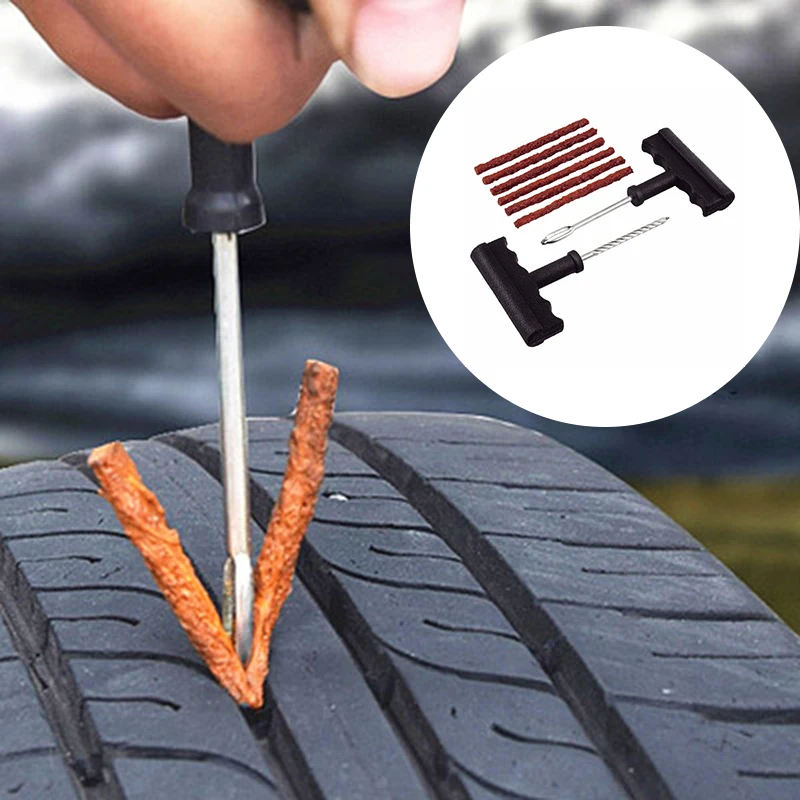 We hope that this knowledge can be helpful to you when you encounter similar situations. Do not hesitate to share the information with your family and friends because they may also need it.
We hope that this knowledge can be helpful to you when you encounter similar situations. Do not hesitate to share the information with your family and friends because they may also need it.
Is the article PERFECT for your needs? Do you have other useful knowledge? Please share with us via the comments below. We are happy to share with you!
Thank you for reading!
This post was last updated onEvery year cars become more perfect and more technologically advanced, which, perhaps, cannot be said about tires - over time, their basic properties do not fundamentally change.
Author: autojournalist
Photo: vinylmonster.ru
That is, in fact, the current tire is the same rubber on the frame as it was. And this means: modern bridgestones and nokia are protected from punctures no better than their ancient counterparts.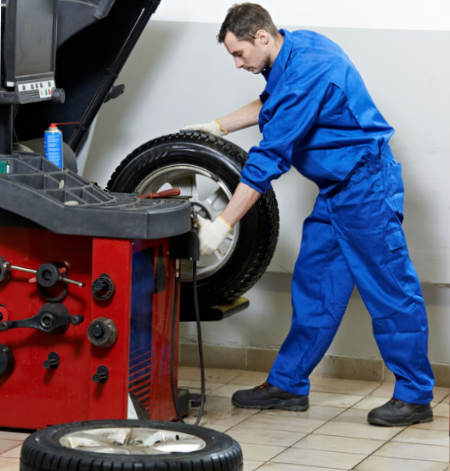 At the same time, the methods of repairing various damages, according to experts, have become much more diverse and effective.
At the same time, the methods of repairing various damages, according to experts, have become much more diverse and effective.
To eliminate a puncture, first of all, it is necessary to "heal" the hole itself - this can be done without resorting to disassembling the wheel, for example, using special harnesses. Those that are included in self-repair kits for tires usually have a textile base. This material is inexpensive and affordable, but short-lived. Therefore, servicemen recommend it only as a temporary remedy.
Rubber bands are more efficient. Moreover, most modern rubber inserts consist of 2 layers. The inner (black) is a regular rubber. The outer (usually blue) layer is cold cured. What, you ask, are the differences? The vulcanization temperature of the first is about 100 degrees, the second is only 18 degrees (subject to surface treatment with chemicals). The latter property makes it possible to achieve complete sintering of repair and base materials without hot working.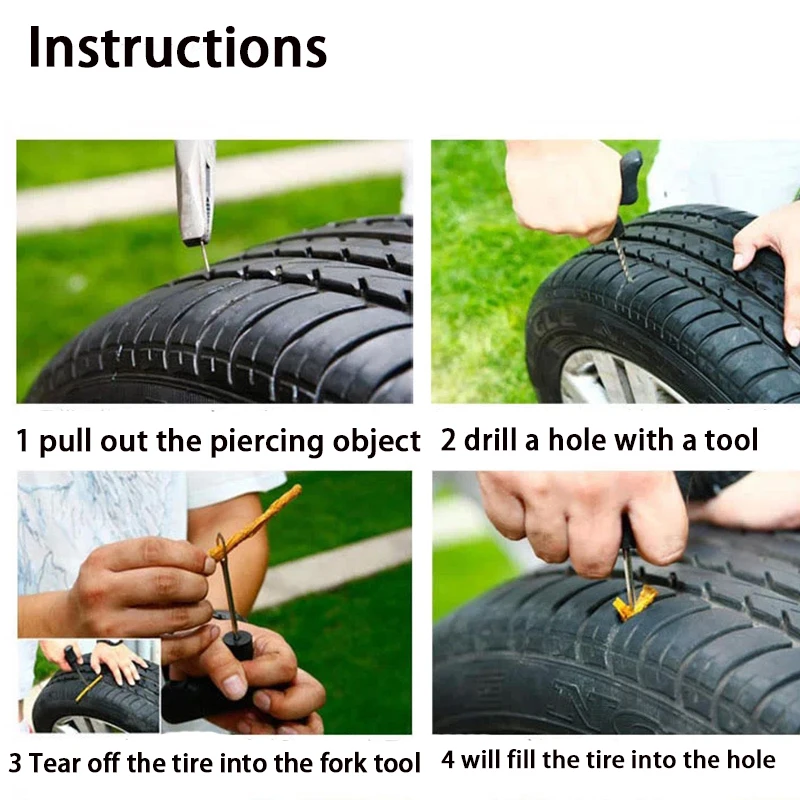
To talk about a complete repair, it is not enough to restore the tightness of the tire alone. Hard objects, in addition to the rubber itself, also damage the cords - this can lead to a change (albeit sometimes insignificant) in the properties of the tire. To avoid them, it is necessary to restore the integrity of the cord - this is exactly what they do at tire fitting points with the help of patches.
The simplest way to do this is to use a so-called “mushroom”, the head of which reinforces the cord from the inside. But there is a caveat: if the object entered the tire at a large angle, the cap will not fit snugly. Therefore, a different method is often used.
A separate insert is mounted into the hole (practically a leg from the "fungus"), which, after vulcanization, is cut from the inside flush with the surface of the tire. It remains only to impose a reinforcing patch.
Similar patches are sometimes used to complete repairs started by the car owner.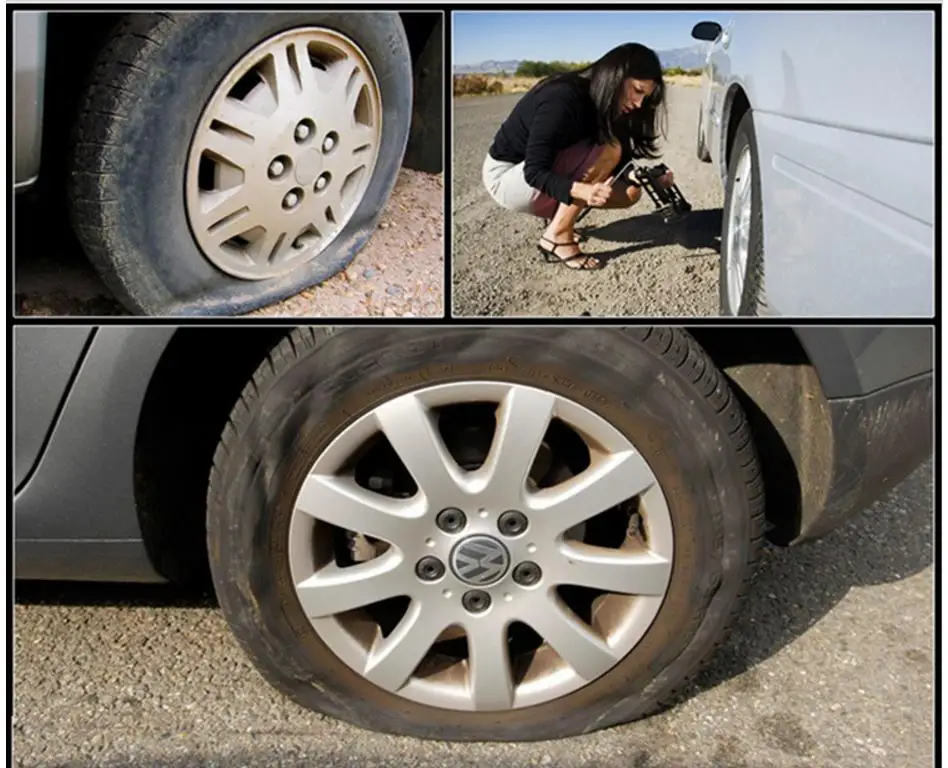 For example, if he did not use ordinary textile harnesses, but rubber ones, the tire fitting employee does not need to “pick out” the hole and “heal” it with his own means. It is enough just to cut off a piece of rubber sticking out inside and apply a reinforcing patch.
For example, if he did not use ordinary textile harnesses, but rubber ones, the tire fitting employee does not need to “pick out” the hole and “heal” it with his own means. It is enough just to cut off a piece of rubber sticking out inside and apply a reinforcing patch.
There is an opinion that to eliminate punctures in tubed tires, it is enough to vulcanize the tube itself - it is it that holds the air. Actually, it doesn't stand up to scrutiny. Not only does the cord remain damaged - moisture will enter the tire through an unpatched hole, which can cause rotting of the textile carcass, as well as abrasive particles that can wipe the tube to holes.
I would not like to throw a stone at all tire shops (especially since the quality of this type of service has grown in recent years), but in some places there are those who are concerned not so much with this very quality of work as with the economic efficiency of their business.
Such points can often be seen on back (dead end) streets, in residential courtyards, and communication with a car owner whose car needs help often happens through a hole in the fence or in some other original way. What are we for? And besides, before handing over a punctured wheel for repair, the first thing to do is at least ask how it is planned to carry it out. If a tourniquet that doesn't hit your pocket, it's better to take the time and look for another tire shop. It’s not a pity to give a little more for a job well done in a good service.
What are we for? And besides, before handing over a punctured wheel for repair, the first thing to do is at least ask how it is planned to carry it out. If a tourniquet that doesn't hit your pocket, it's better to take the time and look for another tire shop. It’s not a pity to give a little more for a job well done in a good service.
Source: https://110km.ru/art/kak-ustranit-dyrku-v-rezine-obsuzhdaem-remont-prokola-shiny-139275.html
what condition each wheel of the car is in. Our company has been repairing car wheels for over 15 years. Our workshops are equipped with the most modern equipment to repair tire punctures at low prices and other damage. Our masters are qualified and periodically undergo various trainings.
Just one puncture or a slight swelling of the rubber significantly reduces the level of safety and driving comfort, and is the most common reason for a car owner to seek a tire service.
These may be the following mechanical defects:
If a tire is damaged, you can install a spare tire, but it must be repaired as soon as possible, since no one is immune from the next puncture of another wheel. It is also important to note that the life of the running gear, and the operation of the car as a whole, also depend a lot on the factors listed above, so never put off repairing damage to the wheel of your car for a long time. This must be done in professional conditions and before wondering how much it costs to repair a puncture, it is better to find a tire service in Moscow with modern equipment and the highest level of service.
This must be done in professional conditions and before wondering how much it costs to repair a puncture, it is better to find a tire service in Moscow with modern equipment and the highest level of service.
| Fungi | Price | Patches | Price | Patches 2 cord. | Price |
| Diameter 3 | 250 | Umid | 150 | R-18 | 400 |
| Diameter 6 | 300 | Umax | 150 | R-20 | 450 |
| Diameter 9 | 350 | R-8 | 200 | R-25 | 500 |
| Diameter 12 | 400 | R-10 | 200 | R-33 | 550 |
Modern cars are characterized by excellent maneuverability and the ability to move comfortably at a fairly high speed. However, these improved parameters are very "dependent" on the condition of several important transmission units, of which the wheels of the car occupy almost a central place. A similar factor is due to the operating conditions: the adhesion of rubber to the road surface and the friction forces arising from the contact of the rubber tread and asphalt. To eliminate any deformation loads, it is important to create a calculated, balanced rolling, and given the high speed, the ideal parameters of the wheel, or rather, the tire and disk as a single component as a whole.
However, these improved parameters are very "dependent" on the condition of several important transmission units, of which the wheels of the car occupy almost a central place. A similar factor is due to the operating conditions: the adhesion of rubber to the road surface and the friction forces arising from the contact of the rubber tread and asphalt. To eliminate any deformation loads, it is important to create a calculated, balanced rolling, and given the high speed, the ideal parameters of the wheel, or rather, the tire and disk as a single component as a whole.
If a car tire has been punctured and no repairs have been made, an imbalance is created:
 The result of such a negative phenomenon is increased tire wear in a certain place, mechanical wear of ball joints (supports, steering tips, rods, silent blocks).
The result of such a negative phenomenon is increased tire wear in a certain place, mechanical wear of ball joints (supports, steering tips, rods, silent blocks). If you do not want to reduce the resource of expensive chassis elements, it is better to take care of their integrity in advance and contact the professionals - the tire fitting masters of the company “….”! We are ready to quickly and inexpensively repair a tubeless tire puncture of any nature, and the low price will be a pleasant surprise for you!
Still have questions?
The nature of the damage can have a variety of physical parameters, which directly affect how the tire puncture will be repaired. Before repairing a wheel, we carefully study the size of the hole, its location, and even the angle at which the entry of a sharp object occurred, as this is an important influencing factor in the speed index. A tubeless tire puncture can be repaired in two ways:
 The advantage of this technology is the elimination of a puncture on the spot if the source of damage is visible (for example, a screw).
The advantage of this technology is the elimination of a puncture on the spot if the source of damage is visible (for example, a screw). A car tire puncture is repaired using the selected technology using a patch of predetermined dimensions and a professional adhesive. The price of the service depends on the area and nature of the damage, as well as on the need to use the hot vulcanization technique.